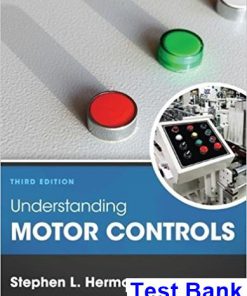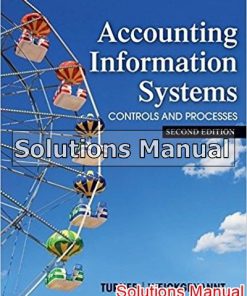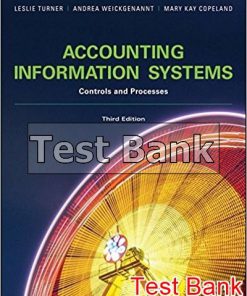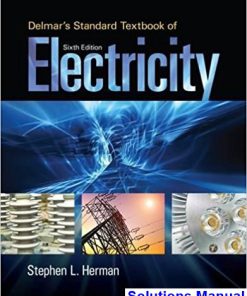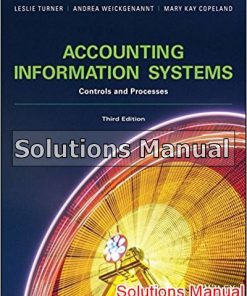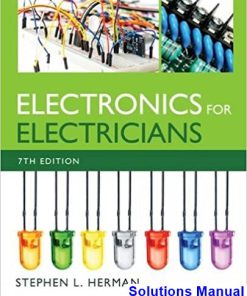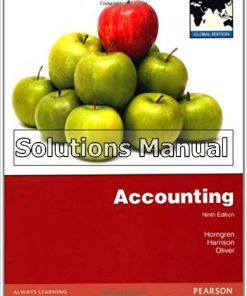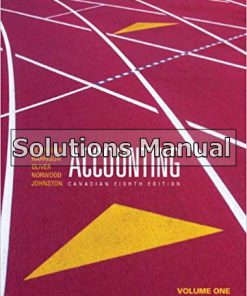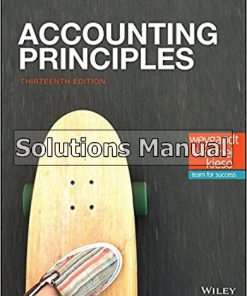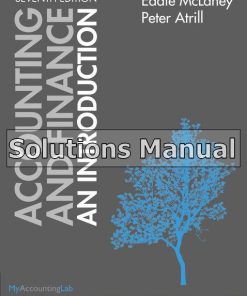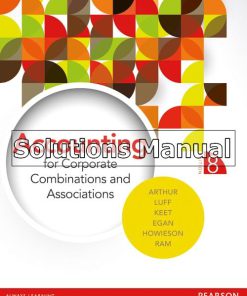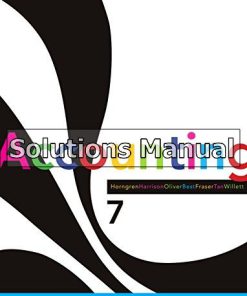Understanding Motor Controls 3rd Edition Herman Solutions Manual
$26.50$50.00 (-47%)
Understanding Motor Controls 3rd Edition Herman Solutions Manual.
You may also like
Understanding Motor Controls 3rd Edition Herman Solutions Manual
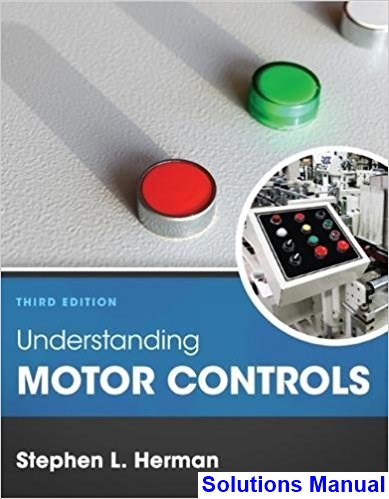
Product details:
- ISBN-10 : 9781305498129
- ISBN-13 : 978-1305498129
- Author: Stephen L. Herman
Using a real-world systems approach to learning motor control devices, UNDERSTANDING MOTOR CONTROLS, 3rd Edition teaches you to install, troubleshoot, and test electrical motors like the pros! Starting with basic control circuits and components, this book covers all must-know applications and procedures to ensure your success in the more complex topics. From safety and development to operations and problem solving, UNDERSTANDING MOTOR CONTROLS prepares you for a career as an industrial electrician with a strong foundation in basic control circuits, sensing devices, solid-state controls, variable speed drives, programmable logic controllers (PLCs), and more. In addition, hands-on lab experiments give you practice putting what you learn into real-world practice.
Table contents:
- Section 1: Basic Control Circuits and Components
- Ch 1: General Principles of Motor Control
- Installation of Motors and Control Equipment
- Types of Control Systems
- Functions of Motor Control
- Ch 1: Review Questions
- Ch 2: Symbols and Schematic Diagrams
- Sensing Devices
- Ch 2: Review Questions
- Ch 3: Manual Starters
- Manual Push Button Starters
- Troubleshooting
- Ch 3: Review Questions
- Ch 4: Overload Relays
- Dual Element Fuses
- Thermal Overload Relays
- Magnetic Overload Relays
- Overload Contacts
- Protecting Large Horsepower Motors
- Ch 4: Review Questions
- Ch 5: Relays, Contactors,and Motor Starters
- Relays
- Electromagnet Construction
- Contactors
- Mechanically Held Contactors and Relays
- Mercury Relays
- Motor Starters
- Ch 5: Review Questions
- Ch 6: The Control Transformer
- Grounded and Floating Control Systems
- Transformer Fusing
- Ch 6: Review Questions
- Section 2: Basic Control Circuits
- Ch 7: Start –Stop Push Button Control
- Ch 7: Review Questions
- Ch 8: Multiple Push Button Stations
- Ch 8: Review Questions
- Ch 9: Forward–Reverse Control
- Ch 9: Review Questions
- Ch 10: Jogging and Inching
- Inching Controls
- Ch 10: Review Questions
- Ch 11: Timing Relays
- Pneumatic Timers
- Clock Timers
- Cam or Sequence Timers
- Electronic Timers
- Ch 11: Review Questions
- Ch 12: Sequence Control
- Stopping the Motorsin Sequence
- Ch 12: Review Questions
- Section 3: Sensing Devices
- Ch 13: Pressure Switches and Sensors
- Differential Pressure
- Typical Application
- Pressure Sensors
- Ch 13: Review Questions
- Ch 14: Float Switches and Liquid Lever Sensors
- Mercury Bulb Float Switch
- The Bubbler System
- Ch 14: Review Questions
- Ch 15: Flow Switches
- Ch 15: Review Questions
- Ch 16: Limit Switches
- Micro Limit Switches
- Subminiature Micro Switches
- Limit Switch Application
- Ch 16: Review Questions
- Ch 17: Temperature Sensing Devices
- Expansion of Metal
- Resistance Temperature Detectors
- Expansion Due to Pressure
- Ch 17: Review Questions
- Ch 18: Hall Effect Sensors
- Principles of Operation
- Hall Generator Applications
- Ch 18: Review Questions
- Ch 19: Proximity Detectors
- Applications
- Metal Detectors
- Mounting
- Capacitive Proximity Detectors
- Ultrasonic Proximity Detectors
- Ch 19: Review Questions
- Ch 20: Photodetectors
- Applications
- Types of Detectors
- Mounting
- Photodetector Application
- Ch 20: Review Questions
- Ch 21: Reading Large Schematic Diagrams
- Ch 21: Review Questions
- Ch 22: Installing Control Systems
- Component Location
- Point-to-Point Connection
- Using Terminal Strips
- Ch 22:Review Questions
- Section 4: Starting and Braking Methods
- Ch 23: Across-the-Line Starting
- Direct Current Motors
- Ch 23: Review Questions
- Ch 24: Resistor and Reactor Starting for AC Motors
- Resistor Starting
- Reactor Starting
- Step Starting
- Ch 24: Review Questions
- Ch 25: Autotransformer Starting
- Open and Closed Transition Starting
- Ch 25: Review Questions
- Ch 26: Wye-Delta Starting
- Wye-Delta Starting Requirements
- Dual Voltage Connections
- Connecting the Stator Leads
- Closed Transition Starting
- Overload Setting
- Ch 26: Review Questions
- Ch 27: Part Winding Starters
- Overload Protection
- Dual Voltage Motors
- Motor Applications
- Three Step Starting
- Automatic Shutdown
- Ch 27: Review Questions
- Ch 28: Direct Current Motors
- Field Windings
- Armature Windings
- Series Motors
- Shunt Motors
- Compound Motors
- Field Loss Relay
- External Shunt Field Control
- Controlling Compounding
- Cumulative and Differential Compounding
- Testing the Motor for Cumulative or Differential Compounding
- Direction of Rotation
- Determining the Direction of Rotation
- Ch 28: Review Questions
- Ch 29: Single Phase Motors
- Centrifugal Switch
- Hot-Wire Starting Relay
- Current Relay
- Solid-State Starting Relay
- Potential Starting Relay
- Dual Voltage Motors
- Reversing the Direction of Rotation
- Multispeed Motors
- Multispeed Fan Motors
- Ch 29: Review Questions
- Ch 30: Braking
- Mechanical Brakes
- Dynamic Braking
- Dynamic Braking for Alternating Current Motors
- Plugging
- Ch 30: Review Questions
- Section 5: Wound Rotor, Synchronous, and Consequent Pole Motors
- Ch 31: Wound Rotor Motors
- Manual Control of a Wound Rotor Motor
- Timed Controlled Starting
- Wound Rotor Speed Control
- Frequency Control
- Ch 31: Review Questions
- Ch 32: Synchronous Motors
- Starting a Synchronous Motor
- Excitation Current
- The Brushless Exciter
- Direct Current Generator
- Automatic Starting for Synchronous Motors
- The Field Contactor
- Out-of-Step Relay
- The Polarized Field Frequency Relay
- Power Factor Correction
- Applications
- Ch 32: Review Questions
- Ch 33: Consequent Pole Motors
- Three-Speed Consequent Pole Motors
- Four-Speed Consequent Pole Motors
- Ch 33: Review Questions
- Section 6: Variable Speed Drives
- Ch 34: Variable Voltage and Magnetic Clutches
- Voltage Control Methods
- Magnetic Clutches
- Eddy Current Clutches
- Ch 34: Review Questions
- Ch 35: Solid-State DC Motor Controls
- The Shunt Field Power Supply
- The Armature Power Supply
- Voltage Control
- Field Failure Control
- Current Limit Control
- Speed Control
- Ch 35: Review Questions
- Ch 36: Variable Frequency Control
- Alternator Control
- Solid-State Control
- Some Related Problems
- IGBTs
- Advantages and Disadvantages of IGBT Drives
- Inverter Rated Motors
- Variable Frequency Drives Using SCRs and GTOs
- Features of Variable Frequency Control
- Ch 36: Review Questions
- Section 7: Motor Installation
- Ch 37: Motor Installation
- Motor Nameplate Data
- Manufacturer’s Name
- RPM
- Determining Motor Current
- Determining Conductor Size fora Single Motor
- Overload Size
- Determining Locked-Rotor Current
- Short-Circuit Protection
- Starter Size
- Example Problems
- Multiple Motor Calculations
- Ch 37: Review Questions
- Section 8: Programmable Logic Controllers
- Ch 38: Programmable Logic Controllers
- Differences between PLCs and PCs
- Basic Components
- Ch 38: Review Questions
- Ch 39: Programming a PLC
- Circuit Operation
- Developing a Program
- Converting the Program
- Entering a Program
- Programming Considerations
- Ch 39: Review Questions
- Ch 40: Analog Sensing for Programmable Logic Controllers
- Installation
- The Differential Amplifier
- Ch 40: Review Questions
- Section 9: Developing Control Circuits and Troubleshooting
- Ch 41: Developing Control Circuits
- Developing Control Circuits
- Ch 41: Review Questions
- Ch 42: Troubleshooting
- Safety Precautions
- Voltmeter Basics
- Test Procedure Example 1
- Test Procedure Example 2
- Test Procedure Example 3
- Motors
- Ch 42: Review Questions
- Section 10: Laboratory Exercises
- Laboratory Exercises
- Foreword
- Parts List for Laboratory Exercises
- Suppliers
- Exercise 1: Basic Control
- Exercise 1: Review Questions
- Exercise 2: Start–Stop Push Button Control
- Exercise 2: Review Questions
- Exercise 3: Multiple Push Button Stations
- Exercise 3: Review Questions
- Exercise 4: Forward–Reverse Control
- Exercise 4: Review Questions
- Exercise 5: Sequence Control
- Exercise 5: Review Questions
- Exercise 6: Jogging Controls
- Exercise 6: Review Questions
- Exercise 7: On-Delay Timers
- Exercise 7: Review Questions
- Exercise 8: Off-Delay Timers
- Exercise 8: Review Questions
- Exercise 9: Designing a Printing Press Circuit
- Exercise 9: Review Questions
- Exercise 10: Sequence Starting and Stopping for Three Motors
- Exercise 10: Review Questions
- Exercise 11: Hydraulic Press Control
- Exercise 11: Review Questions
- Exercise 12: Design of Two Flashing Lights
- Exercise 12: Review Questions
- Exercise 13: Design of Three Flashing Lights
- Exercise 13: Review Questions
- Exercise 14: Control for Three Pumps
- Exercise 14: Review Questions
- Exercise 15: Oil Pressure Pump Circuit for a Compressor
- Exercise 15: Review Questions
- Exercise 16: Autotransformer Starter
- Exercise 16: Review Questions
- Appendix
- Glossary
- Index
People also search:
understanding motor controls 3rd edition pdf
understanding basic motor controls answer key
what are 3 types of motor controls
understanding motor controls pdf
understanding motor controls 4th edition answer key

